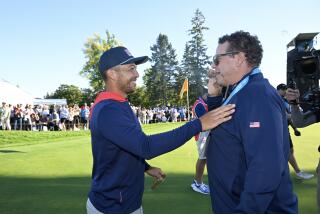AMERICA’S CUP 1987 : Conner Tries to Regain a Grip on Cup : Three Years After Losing It, He’s Close to Winning It Back
- Share via
FREMANTLE, Australia — It’s been nearly four months since the America’s Cup fleet sailed into town.
Hopes have been sunk and hearts broken but life has gone on.
People have gotten married: USA skipper Tom Blackaller and America II publicist Jack Wilkie.
Babies have been born: Eagle skipper Rod Davis has a daughter he didn’t have when he got here. ESPN analyst Gary Jobson has twin daughters.
This isn’t a sporting event . It’s a season. The playoffs are over and the competition is at last clearly and critically defined.
On one side is the relentless Dennis Conner, a love-hate anti-hero who is known better in this country than at home, and whom Australians certainly feel they know far better than their own campaigner, Iain Murray of the enigmatic Kookaburra syndicate.
They’ll sail a best-of-seven series that will determine if Conner, 44, reclaims the prize he won in 1980 and lost to Australia II in ‘83, or if Murray--a confessed introvert--takes his place uncomfortably in the glare of sailing’s greatest achievement.
It shapes up as a colorful series, Conner’s big, blue boat with the strikingly distinctive sheer-line curve and Murray’s metallic golden 12-meter, reflecting one of the nation’s sporting colors.
Each boat won 35 of 43 races to get here up opposite sides of the elimination ladder, and they left no doubt of their credentials.
In the challenger finals, Conner disposed of archrival Blackaller and his intimidatingly fast double-ruddered boat in four straight races, then dismantled New Zealand’s hotshot KZ7 crew, 4-1.
Kookaburra III blew away Australia IV, the descendant of Australia II, in five straight, a victory soured by syndicate boss Kevin Parry’s blasts at the popular loser, Alan Bond. They have since made up, but the incident for a time left embarrassed Australians with nobody to root for.
Otherwise, the Kookas were a quiet syndicate that nevertheless aroused considerable controversy with its penchant for protests and its blatant attempt to manipulate the scoring tables in cozy races against stablemate Kookaburra II.
It worked. Australia IV was the fastest boat in the defender semifinals but lost four races on protests and finally had to cut a deal with the Kookas to forestall another protest and get into the final--the day before the protest was thrown out.
At that point, Bond’s luck went straight to the bottom. His genius designer, Ben Lexcen, developer of the winged keel in ‘83, over-tinkered before the finals and turned the boat into a slug that became easy prey for Kookaburra III, then quietly retired.
And if the boat did have a chance, the helmsman, Colin Beashel, threw it away with some of the biggest blunders seen in top-level sailing.
That doesn’t mean Kookaburra III survived by default. Murray, given a free hand and open account by Parry, assembled a high-tech, well organized program whose only apparent weakness was public relations.
That, to the surprise of many, is where Stars & Stripes came on strong. Conner has been at times irascible and inconsiderate--in other words, his old self--but at other times Prince Charming, Mr. Wonderful and man of the year rolled into one.
And what a roll. After losing four races in November when they dumped too much lead into the boat and the wind died, Stars & Stripes has been on what the syndicates like to call an upward curve of boat and sail development. Everything they do seems to make Stars & Stripes ’87 go faster, especially in strong wind.
The November fiasco stamped the yacht as a heavy weather boat, an implied stigma that suggests it is vulnerable on days when the Fremantle Doctor is out.
At least, it seems, that’s the line of propaganda Stars & Stripes has been putting out.
Remember how they set up Blackaller? Remember how they messed up the Kiwis?
Beware, Kookaburra, beware.

